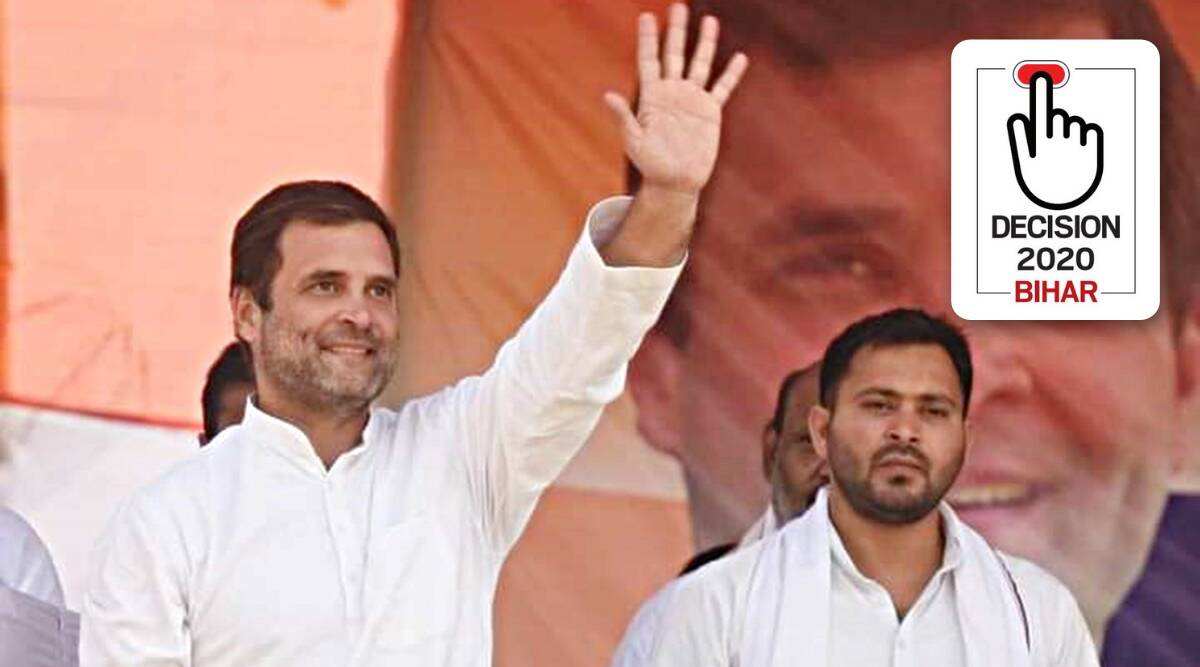 Congress leader Rahul Gandhi with Grand Alliance's chief ministerial face Tejashwi Yadav at a public meeting in Hisua in Bihar's Nawada district. (File Photo)
Congress leader Rahul Gandhi with Grand Alliance's chief ministerial face Tejashwi Yadav at a public meeting in Hisua in Bihar's Nawada district. (File Photo)With the Assembly election in Bihar going down to the wire late of Tuesday night, the Congress emerged as the weakest link in the RJD-led grand alliance, perhaps keeping it from crossing the halfway mark.
The Congress, which had contested 70 seats, had won just 14 and was leading at another 5 — a strike rate of 27 per cent. It had done especially badly in the seats where it was in a straight fight with the BJP.
The three Left parties — CPI(ML), CPM, and CPI — had won or were leading in 17 of the 29 seats that they had contested, a strike rate of 58.6 per cent.
The RJD, which had contested 144 seats, had won 60 and was leading at 16 — a strike rate of about 53 per cent — according to data on the Election Commission website at 11.15 pm on Tuesday.
Of the 70 seats that it contested, the Congress was up against the BJP in 37 – and it had won or was leading at just 7.
It had won or was leading at 10 seats against JD(U) candidates, and at 3 seats where it contested against the Hindustani Awam Morcha (Secular).
Of the 30 seats where it was trailing or had lost to BJP candidates, the Congress had been pushed to third place in three – Chainpur, Gopalganj, and Paroo.
Overall, the Congress had lost or was trailing at 51 seats, and among those falling behind in the count were actor-politician Shatrughan Sinha’s son Luv Sinha in Bankipur, and veteran socialist leader Sharad Yadav’s daughter Subhashini in Bihariganj.
A leader of one of the constituents of the opposition alliance told The Indian Express that the outcome could have been different had the seat sharing been done in a more “rational” manner.
“I think if we could have formed an alliance earlier and the seat allocation was more rational… For example… I think at least 50 seats for the Left and 50 seats for the Congress would have probably been a more reasonable, fair distribution of seats. That could have possibly affected the results better,” CPI(ML) general secretary Dipankar Bhattacharya said.
Congress sources, however, argued that the 70 seats the party contested were “traditionally non UPA/non-Congress seats, where the strike rate of the NDA had been more than 95 per cent”.
Said a Congress leader: “Whenever the JD(U) and BJP come together they become a deadly combination based on their caste and social composition. In 2010 when the BJP and the JD(U) fought together they won 65 out of these 70 seats. The BJP had won 33 out of 36 and the JD(U) won 32 out of 34. Similarly, in the 2019 Lok Sabha elections, BJP and the JD(U) fought together, they led in 67 out of the same 70 seats. BJP led in 25 out of 26 segments and JD(U) led in 28 out of 32 segments.”
This leader said the BJP had won 24 out of these 70 seats even in 2015, when it fought without the JD(U). Given that the NDA has traditionally been strong at these 70 seats, blaming just the Congress would be unfair, the leader said.
What would be worrying for the Congress though, is its performance in Seemanchal, a region with a significant Muslim population. Out of the 11 seats it contested in the region, the Congress had won or was leading on only 5. Of the remaining six seats, the AIMIM was ahead in two – Amour and Bahadurganj. In Bahadurganj, the Congress had been relegated to the third position after the VIP.
The Congress had won 8 seats in Seemanchal in the last Assembly election. Overall, the Congress had won 27 of the 41 seats it had contested the last time. The Congress has increased its vote share from 6.66 per cent in 2015 to 9.5 per cent this time.
A section of the RJD had been arguing that the Congress was given at least 15-18 seats more than what it should have got. Congress in charge of Bihar Shaktisinh Gohil had, however, told The Indian Express during the campaign: “We had identified 95 seats and asked for 70 seats out of those… We had to remain with the alliance, and the RJD, being the largest party, wanted everyone to be flexible and adjust a bit…”